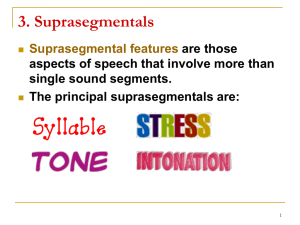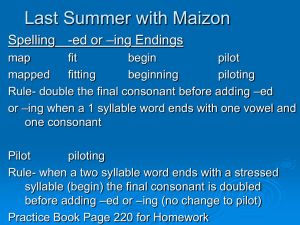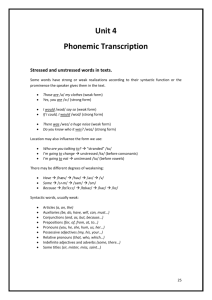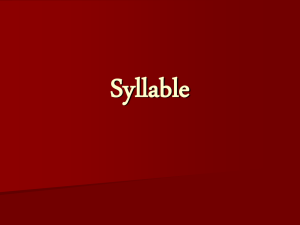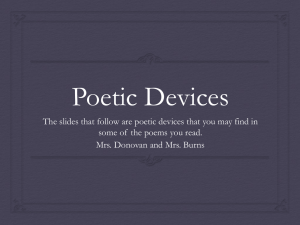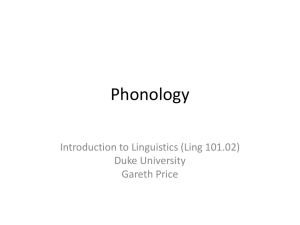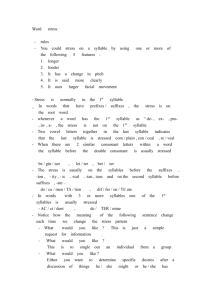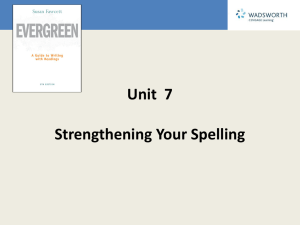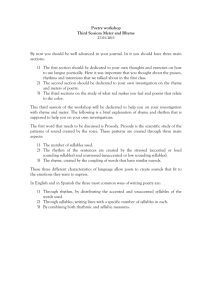Phonotactics
advertisement
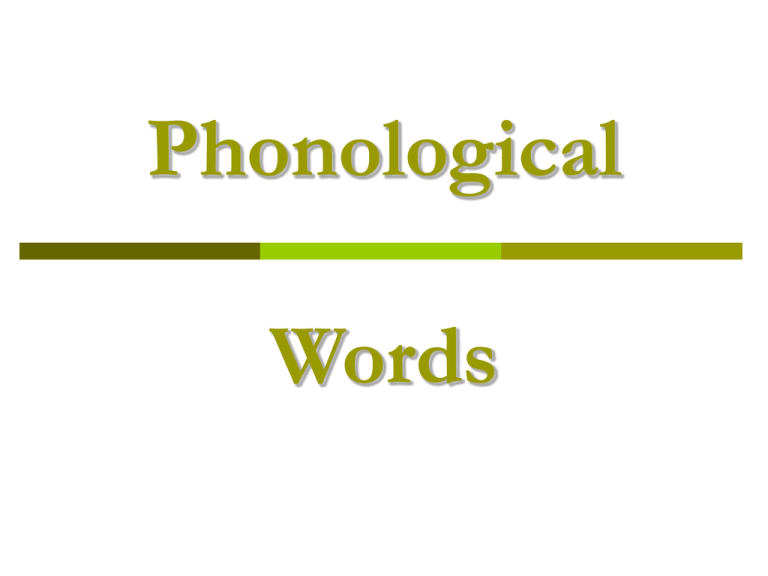
Phonological Words timp rog mbott o flezk spink beh bod psore Give each of the strings of sounds a numerical rating, from 1 to 5, where 1 means the string is definitely not an English word, and 5 means that it definitely is an English word. Arrange the words in order according to the scores you assign, lowest to the highest. 2 5 4.66 4.3 4.5 4.2 4.17 4 3.5 2.75 3 2.5 2.02 2 1.69 1.5 1.07 1 0.5 0 bod timp rog spink beh psore flezk mbotto 3 Bod gets a high score because it actually is a word of English (short for body); mbotto gets a low score and it is clearly not a word of English. Why do timp, rog, and spink get higher scores than mbotto? They are not English words either! 4 5 IOBUZRP ZOIP, ZURP, ZOUB, ZOIB, ZIRB, ZORB, ZIRP, ZURB, ZUBI, ZOPI, ZORI… zori, n. Japanese thonged sandals with straw (or leather, wood, etc.) soles. From Japanese so “grass, (rice) straw” and ri “footwear, sole.” 6 The point is, there are hundreds of arrangements of letters that you will never even consider as potential English words: ZPOI, ZROB, ZIPB, ZBRP, ZIUO… What is it that you know that makes you pause and wonder whether ZIRP might be a word of English, but makes you pass over ZIPB? 7 Phonotactics The rules that describe possible sequences of sounds for forming English words. Language can differ in their phonotactic rules, so that mbotto might be a possible word of Swahili, or psore a possible word of Greek. 8 One condition on a well-formed English word is that it has to be made up of at least one syllable, which is roughly a phonological unit that contains at least a vowel. Syllables can start or end with one or more consonants, but even without any consonants, a vowel can be a syllable all by itself. 9 Phonotactic rule 1: All phonological words must contain at least one syllable, and hence must contain at least one vowel. People pay attention to syllables in a number of ways. A very obvious one is in metered poetry: two lines of poetry that scan, i.e. that fall into a regular rhythmic pattern, usually have the same number of syllable. 10 Jabberwocky: a nonsense poem ’Twas brillig, and the slithy toves Did gyre and gimble in the wabe. All mimsy were the borogoves And the mome raths outgrabe. The first three lines all contain eight syllables, and the last one is shorter, with six syllables. This pattern is repeated throughout the poem: 11 One, two! One, two! And through and through The vorpal blade went snicker-snack! He left it dead, and with its head He went galumphing back. Considering that Lewis Carroll made up most of the words in the poem, he must have intended for the syllable counts to turn out this way—it can’t just be a coincidence. 12 Sometimes poets will play with the intuition that syllable counting is an essential ingredient of verse. Consider the first two verses of Poetical Economy by Harry Graham: 13 What hours I spent of precious time What pints of ink I used to waste, Attempting to secure a rhyme To suit the public taste, Until I found a simple plan Which makes the lamest lyric scan! 14 When I’ve a syllable de trop I cut it off, without apol. This verbal sacrifice, I know, May irritate the schol; But all must praise my dev’lish cunn. Who realize that Time is Mon. 15 In the opposite direction, what about this Rhyme for Remembering the Date of Easter, by Justin Richardson? No need for confusion if we but recall That Easter on the first Sunday after the full moon following the date of Equinox doth fall. 16 This particularly unmemorable rhyme fails as a mnemonic and succeeds as a joke because it doesn’t scan: trying to remember the rhyme is just as hard as trying to remember the plain prose fact. A good mnemonic rhyme scans, giving it a rhythm that helps you fit in the right individual words, as in the first two lines of this famous mnemonic for remembering the number of days on a month: 17 Thirty days hath September April, June, and November. 18 Phonotactic rule 2: Sequences of repeated consonants are not possible. /sssitttt/ As the snake slid swiftly past him, Harry could have sworn a low, hissing voice said, ‘Brazil, here I come…Thanksss, amigo.’ 19 Phonotactic rule 3: The glottal fricative /h/ never occurs in the coda of a syllable. This rules out the possibility of beh. 20 To rule out flezk and zipb Other coda rules: If the second consonant in a complex coda is voiced, the first consonant in the coda must also be voiced. When a non-alveolar nasal is in a coda together with a non-alveolar obstruent, they must have the same place of articulation, and the obstruent must be a voiceless stop. Two obstruents in a coda together must have the same voicing. 21 To rule out psore and mbotto Onset rules: /ŋ/ is not a possible onset. Complex onsets may not contain affricates or /h/. Two-consonant complex onsets may contain either: A. first consonant: /s/; second consonant: nasal, liquid, glide or voiceless obstruent (except //). B. first consonant: any obstruent other than /s/; second consonant: liquid or glide (l,r,j,w). 22 Stress and rhythm Limerick: A foolish young hunter named Shepherd Was eaten for lunch by a leopard. Said the leopard, “Egad! You’d be tastier, lad, If you had been salted and peppered!” 23 Lame-erick: A foolish farmer chased elephants. Elephants were squashing his best plants. The foolish farmer was Mad as a bee abuzz. His angry hopping seemed like a dance. 24 Limerick la la la la la LA la LA la la LA la LA LA la la la la la la LA la la LA la LA la la LA la la LA la LA LA la la LA la wSwwSwwSw w w S w w S 25 Lame-erick A FOO.lish FAR.mer chased EL.e.phants w S w S w w S ww The FOO.lish FAR.mer was w S w S w w MAD as a BEE a.BUZZ S wwS wS 26 Foot patterns in English MOther apPEAR TElephone comPUter redeFINE Sw wS Sww wSw wwS Trochee Iamb Dactyl Amphibrach Anapest 27 If a word has two syllables, it is more likely to have a Sw pattern. Common trisyllabic words have a Sww pattern. 200 180 160 140 120 100 80 60 40 20 0 Trochees Iambs Dactyls Other 28
